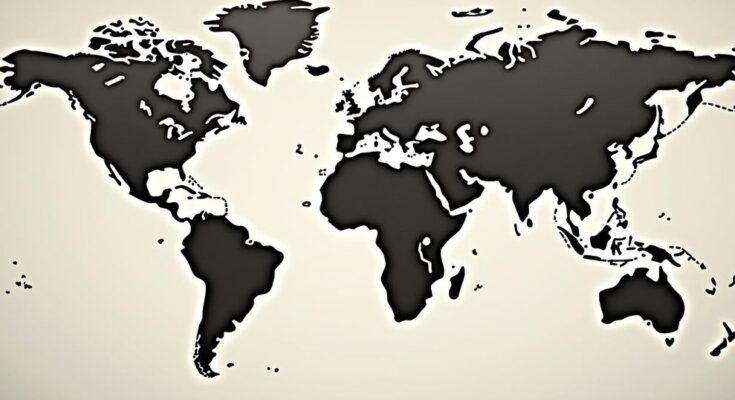Israeli Prime Minister Benjamin Netanyahu presented two maps at the UN General Assembly, categorizing countries as either ‘The Curse’ or ‘The Blessing’ while notably omitting Palestine from both. He linked Iranian influence to regional conflicts and maintained a hopeful stance toward normalization with Arab nations, despite the complications arising from the ongoing conflict between Hamas and Israel.
During a recent address at the United Nations General Assembly, Israeli Prime Minister Benjamin Netanyahu presented two distinct maps, each symbolizing his perception of the geopolitical landscape in the Middle East. The first map, labeled “The Curse,” illustrated countries such as Iran, Iraq, Syria, and Yemen in black, while the second map, entitled “The Blessing,” showcased allies painted in green, including Egypt, Sudan, Saudi Arabia, and India. Notably absent from both representations was any mention of Palestine, which raised eyebrows regarding the ongoing conflict in the region. Netanyahu firmly linked Iranian influence to regional instability, asserting that Iran and its affiliates are the principal architects behind the violence affecting Lebanon, Syria, and Yemen. He cited the Iranian financial and military backing for Hezbollah and Hamas as key factors contributing to turmoil in these areas. “If you strike us, we will strike you,” Netanyahu cautioned, emphasizing Israel’s readiness to defend itself against Iranian-backed threats. His display of the green map prominently featured Saudi Arabia, whose potential normalization of relations with Israel had been a topic of significant discussion, particularly prior to the recent conflict between Hamas and Israel. Despite tensions, Netanyahu attempted to convey optimism regarding future relations with Riyadh, notwithstanding Saudi Arabia’s prior stipulation that the establishment of a Palestinian state is a prerequisite for normalization. Egypt also figured prominently on the map, reflecting its long-standing, albeit complex, peace with Israel since the 1979 treaty. The relationship, while strained, remains crucial for regional stability, especially regarding security in Gaza. Meanwhile, Sudan, having recently normalized ties with Israel through the Abraham Accords, seeks to enhance its standing with the United States and regional allies. India’s presence on the “blessing” map illustrates its growing partnership with Israel, especially in defense and technology, despite its historical support for Palestinian self-determination. This evolving dynamic indicates a significant strategic shift under the current Indian government.
Netanyahu’s address at the UN raises significant questions about recognition and representation in the ongoing Israeli-Palestinian conflict. His maps serve not only as a visual aid but also as a political statement reflecting Israel’s stance towards its neighbors, particularly in the context of Iranian influence and shifting alliances across the Middle East. The omission of Palestine from these maps can be interpreted as a denial of its statehood and further complicates the prospects for peace. Netanyahu’s references to countries like Saudi Arabia, Egypt, and Sudan highlight the delicate balance of diplomatic relations being negotiated against a backdrop of regional unrest.
In conclusion, Benjamin Netanyahu’s presentation at the UN highlighted a stark division in the perception of allies and adversaries in the Middle East, as represented through his maps. By excluding Palestine and focusing on Iranian influence, he emphasized Israel’s defensive posture while projecting a hopeful outlook towards normalizing relations with key Arab nations. The implications of these choices reflect ongoing diplomatic tensions and the challenging path ahead for peace in the region.
Original Source: www.ndtv.com




